A Pine Barrens icon shuts its doors
A little before three o’clock last Saturday afternoon, November 19, Albertus V. Pepper Jr., age 72, of Chatsworth and Washington “Wash” Orme, 85, of Tabernacle, walked into Buzby’s General Store in Chatsworth, via the commercial kitchen. They were in a state of high animation, shouting back and forth, over and around the heads of fellow patrons.
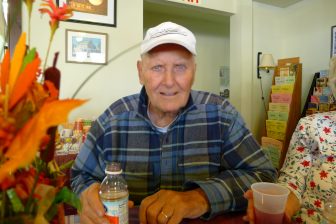
Wash Orme
Buzby’s, in the spiritual heart of the New Jersey Pine Barrens, had been closed (mostly) since last spring when its 87-year-old owner, R. Marilyn Schmidt, fell ill. Marilyn spent most of the summer in the hospital. Friends opened her shop in October for the Chatsworth Cranberry Festival and last Saturday for a fundraiser, to help cover Marilyn’s medical expenses. Dirty-water hot dogs steamed in the kitchen, and coffee and light snacks were served. Tables had been arrayed across the shop floor and at them sat a genteel mix of local historians, antiquarians, scholars, media folk and friends of Marilyn.
Wash and Al represented a throwback to the pre-Marilyn era. In the general scrum that accompanied their arrival, I heard the words “Governor Fielder” along with “late seventeenth-early eighteenth century” issue from the direction of Al Pepper, who is also known as “Chip.”
“Do you know that Governor Fielder in the late seventeen hundreds wanted the Pine Barrens done away with because we were a pollutant to mankind?” he said.
Chip was off on his dates, but James Fielder’s name had once been notorious in the Pines over his support for a plan by Vineland eugenicists to quarantine the woods on the grounds that its native Piney population contained outsize numbers of “feeble-minded morons” who became wards of the state. I had no idea Fielder was still notorious.
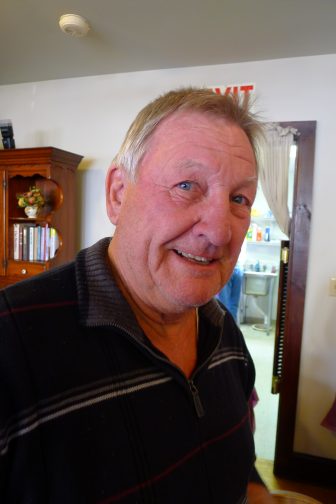
Ablertus “Chip” Pepper, 72, Chatsworth
In less civilized times, Chip and Wash might have been called Pineys, but Chip had an update on the local demonym as well.
“We are no longer called Pineys,” he said.
“What are we?” Wash asked.
“We are Native Pine-Barrens Americans.”
“Always have been, what are you talking about?”
Undeterred, Chip said he would be setting forth his argument for the new nomenclature in a forthcoming book, and he was planning a clothing line to take advantage (I’m guessing) of the recent surge in interest in the white rural underclass. Piney-pride hats and bumper stickers have been available for years anyway.
“You think L.L. Bean’s got the attire? Wait ‘till you see my Native Pine-Barrens American stuff coming out, dude,” he said.
In a more rustic iteration, Buzby’s general store, which opened 151 years ago, sold motor oil, eggs, shot-gun shells, bread, well-restorer, milk, gas-line dyer, hot coffee, boots and penny candy, among other essentials. During deer season, the store became a weigh station for dead ruminants and it was a social hub for the inhabitants of the surrounding Pine Barrens. Men whose nearest neighbor might live five miles away could congregate atop the radiator at Buzby’s and gossip like an Upper West Side lunch claque.
Since the late 1990s, when Marilyn restored and reopened the place as a gift shop and sometime café, it has sold cranberry jams, books about the Pine Barrens, books by Marilyn, stuffed birds that sing facsimiles of the songs they sing in real life, potboilers, Christmas ornaments, Clevenger bottles from a factory in Clayton, antique furniture, Marilyn’s artwork, cranberry scoops and various other articles of Pine Barrens paraphernalia. Marilyn has said she views the place as a Pine Barrens resource center.
On Saturday morning, at one of the tables was a piece of silver fabric on which someone had written in pencil, “Piece of cover of Emilio Carranza plane which fell July 12, 1928 at Sandy Ridge, N.J.” In one of Buzby’s rare brushes with history, the famous aviator Carranza, flying back to Mexico City after a goodwill flight to the United States, crashed his Ryan monoplane in the Pine Barrens. Veterans from the local Mount Holly post of the American Legion claim their members trekked twenty-five miles, hacking a path through the underbrush, to recover the body, but in the local version of events, Carranza was discovered not by energetic legionnaires but by Henry Carr, a Chatsworth resident, who found the wreckage while out on a huckleberry-picking expedition and returned to town for reinforcements. Among the recovery party was Albertus V. Pepper Sr., Chip’s dad, then about ten years old, who helped carry the body back to Buzby’s, where it was kept in the barn behind the general store.
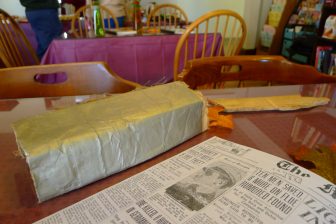
A piece of the wing of Emilio Carranza’s airplane, which crashed outside Chatsworth in July, 1928
“None of that’s true,” Marilyn said last week, of the American Legion story. “I called them out on it, and they said I was an old crab.”
Marilyn has been trying to sell Buzby’s for the better part of five years, at least, but the task has taken on some urgency in recent months as her health has failed. She is neither a local nor a Piney by strict standards having acquired Buzby’s when she was 70 years old, living in Barnegat Light. In one of her many earlier careers she had been an executive at a pharmaceutical company when she was approached to write a book, which became the Harper’s Handbook of Therapeutic Pharmacology.
Marilyn liked the writing, but her experience producing the book convinced her that a publisher was neither necessary nor advisable. She has since written, and self-published, more than sixty books, including Churches and Graveyards of the New Jersey Pine Barrens, A Guide to New Jersey’s Lighthouses and The Bat Book (Marilyn likes bats). Many are cook books with lyrical titles (Mustard Magic! The Best of Blueberries, Simply Shrimp!) and many of the cook books are seafood cook books. She is witty, even when she is writing about mollusks, swordfish or the orange roughy (“It is considered a ‘neutral’ fish, practically indestructible”).
Her favorite book, A Sampler of Canned Seafoods, begins with an exhortation. “Canned seafood should be kept in every kitchen for use in every conceivable culinary emergency.” Her book Piney Talk is a dictionary of neighborhood slang. “I was afraid of the locals getting offended by that. And it was just the opposite. They loved it. Oh, they bought half a dozen at a time.”
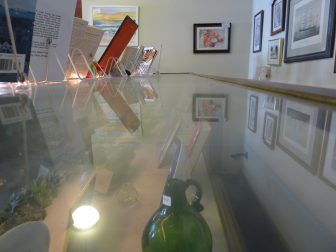
A much-used counter from Buzby’s.
Marilyn’s burgeoning publishing empire took her on trips around the state including to Chatsworth, on the festival circuit, where she enjoyed having breakfast at Buzby’s, before the place closed. According to John McPhee, whose classic book The Pine Barrens (available from Marilyn) deals with Buzby’s at length, the general store was run by Willis Jefferson Buzby “the King of the Pines” from 1894 to 1939 when it was taken over by his son, Willis Jonathan Buzby, also a “King of the Pines” and his wife Katie.
According to Albert Morison, a local builder who renovated the general store after Marilyn bought it, (and whose mother lives behind it) the biggest week of the old Buzby’s year was deer season, when men from the surrounding gun clubs would order their food for the week through Jack Buzby. The general store had one of the few pay phones in a large swath of semi-feral central New Jersey, and outside a long line of deer hunters would form, waiting to call home.
“Guys would come here in the morning and tell their hunting stories,” Chip Pepper said on Saturday. At one point Wash Orme pointed to a mysterious beam in the middle of the floor.
“What’s it there for? It don’t even hold up nothing.”
“It used to be a stairwell,” someone said.
“I know. That’s how you went down the cellar.”
Wash said a retreat by Jack Buzby to the cellar was a signal to the youth of Chatsworth that Christmas had come early, and the would “steal him blind” from the candy counter.
“Poor Jack. I’m digging in the past,” he said.
“We did it, and we’re glad.”
Don Shepherd said he remembered pre-Marilyn Buzby’s when, on one of his regular trips from a girlfriend’s house in Tabernacle to his job at Viking Yachts, his car froze up outside Chatsworth and he had to hike back in to Buzby’s, which was open at six a.m. and full of deer hunters, to buy the aforementioned gas-line dryer. Around this time he was looking to buy land to build a house in Chatsworth and he would stop to have breakfast at the general store, sitting in the alcove where Marilyn’s cash register is now. He now lives a few miles outside Chatsworth commutes in to Philadelphia where he works for the University of Pennsylvania athletic department. He remembers the shop had a cooler and sold milk and other emergency supplies, but a few months after he moved to the neighborhood, the old Buzby’s closed down.
“Hell, this would probably be an empty lot right now if she didn’t restore the place,” he said.
By the early 1990s, Buzby’s was closed long enough to have fallen into disrepair. Neighbors said it would likely have been condemned, or burned down, had fate not intervened in the form of Marilyn. Al Morison, the builder, said kids were breaking in to the shop, “smoking cigarettes and partying a little bit.” Also, there were hundreds of bats that shat copiously in the attic.
Marilyn said her life in Barnegat Light at this time was “quiet, calm, and peaceful.” She lived in a house she’d designed herself overlooking the lighthouse. On the other hand, she couldn’t get a cup of coffee in Chatsworth, thirty miles away. She would encourage friends to buy the shuttered general store, and they would tell her she should buy it.
Her first step was to find a lawyer to foreclose, since the store had been seized for non-payment of taxes, and a financial firm in Bordentown owned the lien. Several lawyers rejected this job over concerns about underground gas tanks that were strewn around the property. Eventually a local cranberry grower helped Marilyn find representation. This process is documented in Marilyn’s latest book, The Rebirth of Buzby’s Chatsworth General Store.
It took two years to buy the lien and foreclose. In the meantime, the building continued to deteriorate. At one point Marilyn had the doors nailed shut to keep the kids from smoking inside, but the displaced teens moved to the barn next door, and that promptly caught fire. The store could have been destroyed. According to Al Morison, it would have been destroyed if it had not had asbestos shingles and a quick-thinking neighbor, Gary Alloway, who was also a forest-fire warden and who drove a brush truck immediately to the scene and turned the hose on the general store ignoring the barn (which was past saving) to prevent the fire from spreading. According to Al, Gary said the side of the store was so hot, the shingles steamed when he hit them with the hose.
When the fire was out, Marilyn contracted Al Morison to renovate the store. When he stopped by Saturday morning, he said the building had been in pretty bad shape. There were structural problems resulting from earlier renovations, including one renovation that had made a load-bearing wall out of a plate-glass window. “Any of these beams you see are actually doing something,” he said, of the new layout.
The roof was removed and replaced, as were the asbestos shingles. A geothermal heating and cooling system was installed and so was a parapet wall above what’s now the kitchen. A hideous drop ceiling—Marilyn’s description—was removed. Two contractors in their eighties un-bricked and restored the fireplace, which had been made with hand-made bricks. Marilyn likes to show people the paw print a raccoon made when the bricks were left out to dry.
When the renovations were underway, Charles Applegate and his wife (name not recorded) stopped by the shop. They had been lifelong friends of Katie Buzby, who had moved across the street when Katie retired from the store, but she had not lived long enough to see it brought back. Marilyn asked them what they thought. After a second, they said, “Katie is smiling!”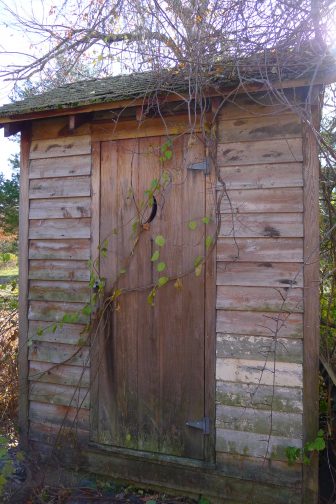
At one time there were 386 bats living in the attic, Marilyn said (the conservation people had counted them), and there was a foot-and-a-half of bat guano at the base of the stairs. Roof removal was delayed to give baby bats time “to mature and migrate,” Marilyn said. Al Morison gave a more modest estimate for the volume of bat guano (“an honest inch or so”). He and an accomplice donned Tyvek suits and respirators and with snow shovels cleaned the bat turds into plastic bags, which they gave either to Al’s father or “Ms. Schmidt” as fertilizer.
One “king bat” harassed the workers throughout the cleanup, Al said.
“This thing was like a mallard. He was bigger than the others, and he kept flying back and forth at us.”
“That’s the only thing I can affirm. There was one big-ass bat.”
White cedar from the unsalvageable hay barn was used to rebuild the outhouse that had been destroyed by the fire, on its original site, and the leftover wood was given to Whitesbog Village to restore their outhouses. The original candy counter that McPhee describes in his book as “rubbed cloudy by hundreds of thousands of coins and pop bottles” is still there (and still cloudy) but the radiator is a replacement. The old outhouse seat was preserved, somehow, from the ashes and presented to Marilyn as a housewarming gift by a friend. She directs reporters to the bathroom to see the “archaeological treasure” which is now hanging on a wall.
“Capt. Lou Puskas rescued this toilet seat from the ruins of the outhouse and returned it to Buzby’s so that it could be preserved,” a sign says.
Marilyn moved in to Buzby’s on Christmas Eve in 1998 as a snowstorm bore down on Barnegat Light. It was just her and her cat, Pumpkin, a 28-pound orange tom (recently described as a “minor tiger”) that liked to catch the bats and bring them to bed. The bats have been suppressed considerably but they were never fully removed. Marilyn is strongly pro bat, on mosquito-control grounds.
Over 700 people signed the guest book at the grand opening of the Cheshire Cat at Buzby’s, and the mayor cut the ribbon. Marilyn served cake and cranberry lemonade. Then she set about applying to the New Jersey Historic Preservation Office and to the National Register of Historic Places to get the site listed. In true Marilyn fashion, she took courses at Burlington County College to learn the “architectural terminology” for the applications. In 2004, the general store was listed in the New Jersey State Register of Historic Places and the National Register of Historic Places.
“Oh, they gave you a plaque,” visitors like to tell Marilyn.
“Yeah, it only cost me a hundred and ten dollars,” she likes to respond.
The original plan for the store had been to run it as a café that sold Pine Barrens products: cranberry jams, blueberry pancakes, muffins, cranberry bread, etc. but she encountered hiccups finding an operator for the café.
“The first tenant I had in said she couldn’t cook,” Marilyn said. “And she couldn’t. I never found out why she wanted to run a café. We ended up in court. It was a disaster.”
A second tenant could cook but also had a wife, one of a number of factors that “impinged on his decisions” (Marilyn’s words).
One year, one of the old families that had owned the shop (post-Jack and Katie Buzby) asked Marilyn if she would host their family reunion. She agreed to do so, expecting about eight people. They arrived in a school bus. “I nearly died,” she said recently.
One family member carried an old attaché case and presented it to Marilyn. Inside were original invoices from the store’s early history. Mr. Buzby would buy merchandise, pay for it, then put the invoice back into the original envelope. The family had saved these records. When they retired to Florida, they needed to do something with them. Because they liked what Marilyn had done to the store, they gave them to her. When Marilyn herself was considering retirement, she contacted Stockton University in Galloway to see if they would be interested. The school was interested but told Marilyn she had to have the documents appraised first. She hired an expert from Princeton, donated the documents and claimed a tax deduction. There is now a Buzby Collection at Stockton’s Bjork Library. Stockton has digitized the documents, to further preserve the documents for anyone interested in the early history of the store.
“They were from the first Mr. Buzby—the old Mr. Buzby who was the father of the last Mr. Buzby,” Marilyn said. “He died in what is now my living room upstairs.”
In recent years the shop has been open a few days a week and by appointment. Marilyn says she views it as a Pine Barrens resource center and it offers the majority of the literature on the Pines, she says. The shop does a brisk business during the Chatsworth Cranberry Festival, when people come in to use the ATM and to complain about the fee to use the ATM, even though there are no banks for miles around and cellphone service is sketchy, especially on festival weekend, when the cell towers are overwhelmed by the influx of visitors.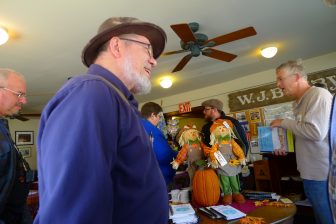
This year people came in to say hi to Marilyn, who made brief appearances each day while her friends ran the store. “Tell her Joni the redhead said hello,” one told me. “She’s really a neat person.”
Occasionally older, Piney-er people would come in and wonder wistfully and out loud if Buzby’s might ever return to the days when there were more deer carcasses and fewer antiques. Marilyn herself thinks the shop should be a café since there’s a pressing need in the neighborhood. Nixon’s General Store is ten miles away. Hedger House, which Don Shepherd said had seemed pretty successful when it was a breakfast-lunch spot, is three miles away but is currently closed. A Wawa near Four Mile Circle is almost eight miles away. “You have to go seven miles for a cup of coffee.”
“I’ve hit the patch and mend era,” Marilyn said last week.
She has a new heart valve and failing kidneys from the toxic dye she was exposed to years ago when she was being treated for a brain tumor. She is on dialysis three days a week and tires easily. Two of her fingers don’t work. She was a typist as a teenager but had to hunt and peck, she said, to finish her last book. Thank god for Tom Kinsella (from Stockton) she said.
She now has a “wardrobe of walkers” she uses to get around the store. A stairlift takes her from the living quarters down to the shop and back. “I have a record of having artificial knees and one foot screwed together and a missing part of an elbow and I’ve had a brain tumor and a few other incidents in between times so everybody keeps giving me walkers. Finally this last time I said, I don’t need a walker!”
Marilyn collapsed on May 21, a Saturday. The day before, the shop had been open. Aside from the Cranberry Fest, it hasn’t really been open since.
“It’s a funny story,” she said to a reporter last week. (“No, it’s not actually,” he responded). It was the morning of the funeral of the ex-pastor of the local church. When Marilyn knew she was having heart trouble, she called 911 rather than phoning a neighbor. As she came downstairs she saw the state police go “zooming down the road.”
“I thought, Oh, boy. There’s a bad accident.” A second later, the cops were on the phone saying they couldn’t find Buzby’s.
“I said, ‘It’s the only store in town!’”
She looked up and saw in front of the hot dog stand the state police, and ambulance and paramedics. She walked out onto the steps and tried to shout, “I’m here! I’m here!” but she could hardly breathe let alone yell. When she finally got someone’s attention and was loaded into the ambulance, the driver announced, “I don’t know where Southern Ocean Hospital is.”
“I mean, it was a three-ring circus when you think about it.”
**
Throughout the afternoon, Chip had been trying to get Wash to tell a story, a piece of verse, it turned out, concerning an “Old Zeph” (or “Old Zeth”) who’d shot an eight-point buck. The story is transcribed, as best I could, below (with Chip’s interjections in parentheses), but you can’t do it justice in print.
When Wash finished, Chip responded with his own ditty, about Ocean Spray the big cranberry cooperative, that was only slightly less poetic than the tale of Old Zeph.
“Do you believe this guy?” Wash said. “Taking over from me is what he’s doing.”
“What are your memories of the Chatsworth General Store?” I asked Wash.
“Where’s it at?”
“He means this place,” his wife said.
“No seriously. Did you hear what he called it? This is Buzby’s,” he said, a finger hitting the table top. “Don’t forget it.”
“Trouble is, there’s an awful lot of memories.”
“I grew up in Tabernacle, but I spent my life here.”
“What did you come here to do?”
“Drank, run women and ride motorcycles—that’s all we did for fifty years. And that’s the truth. Don’t even laugh, ‘cause that is really the truth. Where’s [Billy Saffin]? Where’s Alfie? Where’s Vinnie? Where’s Jughead? Where they all at? ‘Come on in boys!’ Probably half of them can’t walk now—eighty years, ninety years, dead.”
“Did you ever hear of a guy named Willy Wasovwich?” Chip asked.
At this point, I was beginning to think he was on the payroll at Farrar, Straus and Giraux. Along with Fred Brown, Bill Wasovwich is one of the main protagonists of John McPhee’s The Pine Barrens.
Chip said he knew the reason Willy was so introverted and that he had sold sphagnum moss for Wasovwich to a store in Maryland, where he used to get a better price than he could get locally. Like a lot of old Pineys, Wasovwich would sometimes make money selling Pine Barrens moss to gardeners. According to both Chip and Marilyn, Wasovwich is still alive, living at a deer-hunting club not far from Chatsworth.
Chip showed Wash pictures of coyotes and rattlesnakes on his cellphone. He’d seen more rattlesnakes in the last two years than he’d ever seen in his life. Coyote numbers seemed to be on the rise as well. “You wonder why there’s no deer population? These guys there. That’s the answer right there.”
They talked about the old days when, during deer season, the old men would congregate in Buzby’s to tell their hunting stories. “All the gun clubs were lined up,” Chip said. They pointed out the windows where the deer would be hung up.
“They gonna shut this down? I don’t want to hear it. I’m outta here,” Wash said.
“I offered to buy it, if Hot Dog Robyn would run it. She said her husband would leave her if she did.”
Robyn Bednar, who runs Hot Diggidy Dog, the hot dog stand, in Chatsworth in the summer, was not contacted for this story.
“I tell you what. It generated a hell of a void in the community when it closed, believe me,” Chip said.
People were starting to leave, saying goodbyes.
“Oh, and remember,” Chip said. “The Lord loves a humble man, not a proud man. So don’t lose sight of that.”
“The Lord loves me,” Wash said. “I’m so happy I can’t stand it, I’ll tell you that.
“Eighty-five years old—my life’s coming to an end. Last time I walk out those doors. You believe that?”
Outside it was a depressing November Saturday afternoon. The sky starting to turn purple, all vestiges of the summer gone. In the bogs, the cranberries were in full blush. Marilyn hadn’t been downstairs for a while. Her friends were giving away the dry goods. For a small donation you could have a package of ready-made corn chowder, or blondie cookie mix. There was no telling when the store would reopen and the food might attract vermin.
——————
Old Zeph, as recited by Wash Orme, November 19, 2016 at the Chatsworth General Store
Me and old Zeph went hunting one day
We had him on the scene
(Yes!)
This lop-eared doe come a’running through she never [garbled letp] no man
Old Zeph was standing just like a brick
Just standing like a rock
(Jesus, you’re right)
Just waiting for her to rustle
Then this big eight-pointer came cracking through
Old Zeph knew just what to do
[Sighted?] his shot a little low on the head
When the shot rang out
The buck fell dead.
(Yeah. Yee whoo.)
Then we all gathered ‘round to see the kill.
And drink some hooch from Snyder’s Fill.
(Snyder’s Fill)
(Made that back in Red Onions. Nobody knows about that.)
Ah, we took that buck to the club house grounds
And men with cameras they gathered round
Old Zeph got his [garbled] beside the deer and pictures were taken from far and near
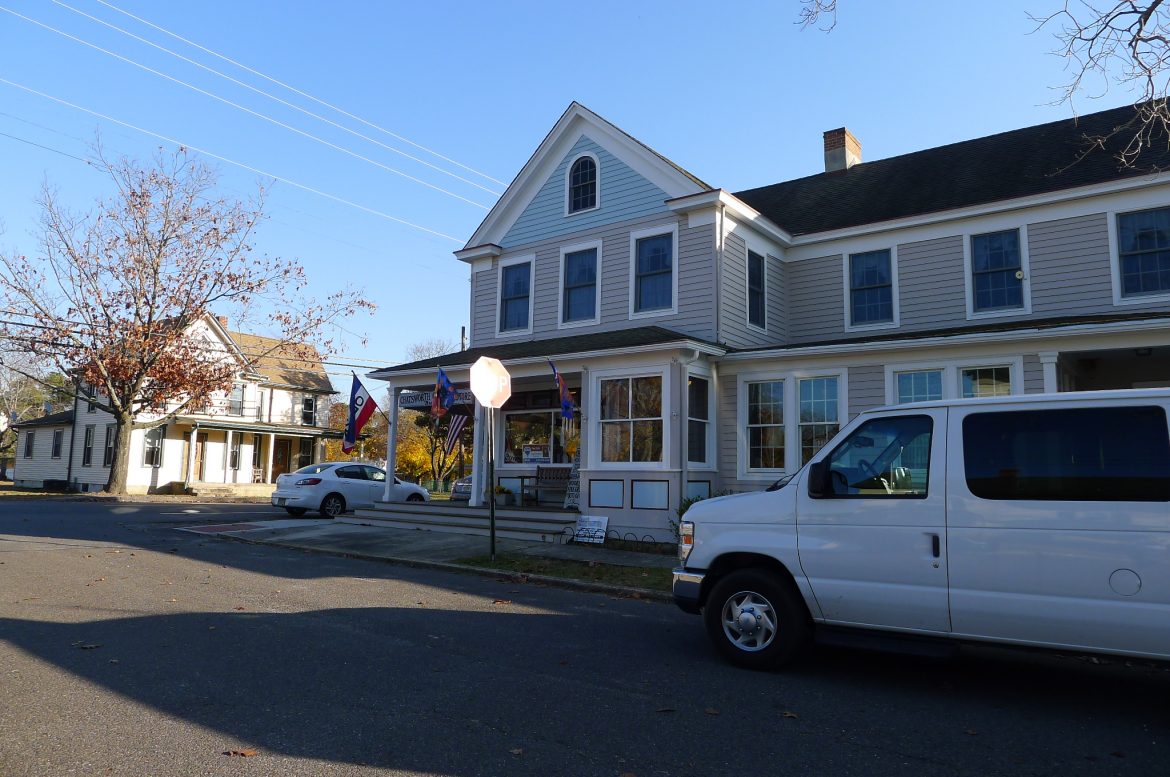
The article on Buzbys Chatsworth was wonderful and appreciated by many. Thank you
I have a pic of My PopPop Russ (Russell Anderson) sitting on a bench at Buzby’s. It was in the National Geographic magazine many years ago. My sister Carole and I would walk from PopPop’s house and collect coca cola bottles, we’d get a nickle a bottle from Mr. Buzby and go home with a little brown bag full of candy, 2 pieces if candy for a penny. I remember the gas pump had the color balls that would go round and round. Oh what great memories! I remember before I was old enough to go to school, the old timers, their wives and all the kids would congregate around the big old tree at the Stevenson house. That was about 50+ years ago. They were quite the times. The old Hedger House, now that place was quite something! I used to go there with MomMom and PopPop Beebe Friday nights. Those times were like no other!